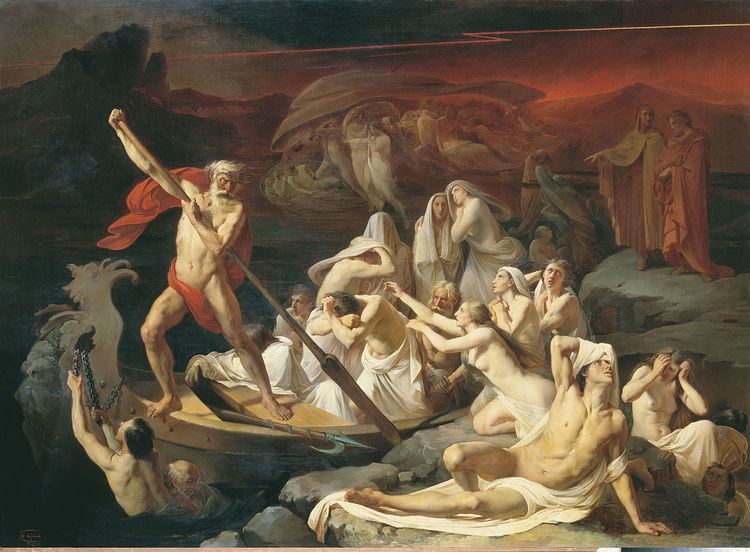 | ||
In Greek mythology, Charon or Kharon (/ˈkɛərɒn/ or /ˈkɛərən/; Greek Χάρων) is the ferryman of Hades who carries souls of the newly deceased across the rivers Styx and Acheron that divided the world of the living from the world of the dead. A coin to pay Charon for passage, usually an obolus or danake, was sometimes placed in or on the mouth of a dead person. Some authors say that those who could not pay the fee, or those whose bodies were left unburied, had to wander the shores for one hundred years. In the catabasis mytheme, heroes – such as Aeneas, Dionysus, Heracles, Hermes, Odysseus, Orpheus, Pirithous, Psyche, Theseus and Sisyphus – journey to the underworld and return, still alive, conveyed by the boat of Charon.
Contents
Genealogy
Etymology of name
The name Charon is most often explained as a proper noun from χάρων (charon), a poetic form of χαρωπός (charopós), “of keen gaze”, referring either to fierce, flashing, or feverish eyes, or to eyes of a bluish-gray color. The word may be a euphemism for death. Flashing eyes may indicate the anger or irascibility of Charon as he is often characterized in literature, but the etymology is not certain. The ancient historian Diodorus Siculus thought that the ferryman and his name had been imported from Egypt.
Appearance and demeanor
Charon is depicted frequently in the art of ancient Greece. Attic funerary vases of the 5th and 4th centuries BC are often decorated with scenes of the dead boarding Charon’s boat. On the earlier such vases, he looks like a rough, unkempt Athenian seaman dressed in reddish-brown, holding his ferryman's pole in his right hand and using his left hand to receive the deceased. Hermes sometimes stands by in his role as psychopomp. On later vases, Charon is given a more “kindly and refined” demeanor.
In the 1st century BC, the Roman poet Virgil describes Charon, manning his rust-colored skiff, in the course of Aeneas’s descent to the underworld (Aeneid, Book 6), after the Cumaean Sibyl has directed the hero to the golden bough that will allow him to return to the world of the living:
There Chairon stands, who rules the dreary coast - A sordid god: down from his hairy chin A length of beard descends, uncombed, unclean; His eyes, like hollow furnaces on fire; A girdle, foul with grease, binds his obscene attire.Other Latin authors also describe Charon, among them Seneca in his tragedy Hercules Furens, where Charon is described in verses 762-777 as an old man clad in foul garb, with haggard cheeks and an unkempt beard, a fierce ferryman who guides his craft with a long pole. When the boatman tells Hercules to halt, the Greek hero uses his strength to gain passage, overpowering Charon with the boatman's own pole.
In the second century, Lucian employed Charon as a figure in his Dialogues of the Dead, most notably in Parts 4 and 10 (“Hermes and Charon” and “Charon and Hermes”).
In the 14th century, Dante Alighieri described Charon in his Divine Comedy, drawing from Virgil's depiction in Aeneid 6. Charon is the first named mythological character Dante meets in the underworld, in Canto III of the Inferno. Dante depicts him as having eyes of fire. Elsewhere, Charon appears as a mean-spirited and gaunt old man or as a winged demon wielding a double hammer, although Michelangelo's interpretation, influenced by Dante's depiction in the Inferno, shows him with an oar over his shoulder, ready to beat those who delay (“batte col remo qualunque s'adagia”, Inferno 3, verse 111). In modern times, he is commonly depicted as a living skeleton in a cowl, much like the Grim Reaper. The French artist, Gustave Dore, depicted Charon in two of his illustrations for Dante's Divine Comedy. The Flemish painter, Joachim Patinir, depicted Charon in his Crossing the River Styx. And the Spanish painter, Jose Benlliure y Gil, portrayed Charon in his La Barca de Caronte.
Underworld geography
Most accounts, including Pausanias (10.28) and later Dante's Inferno (3.78), associate Charon with the swamps of the river Acheron. Ancient Greek literary sources – such as Pindar, Aeschylus, Euripides, Plato, and Callimachus – also place Charon on the Acheron. Roman poets, including Propertius, Ovid, and Statius, name the river as the Styx, perhaps following the geography of Virgil’s underworld in the Aeneid, where Charon is associated with both rivers.
In astronomy
Charon, the second dwarf planet of the Pluto-Charon system, is named after him.
"Haros" and modern usage
"Haros" is the modern Greek equivalent of Charon, and usage includes the curse "you will be eaten (i.e., taken) by Haros", or "I was in the teeth of Haros" (i.e., "I was near death/very sick/badly injured"). During the Korean War, the Greek Expeditionary Force defended an outpost called Outpost Harry. The Greek soldiers referred to it as "Outpost Haros".
